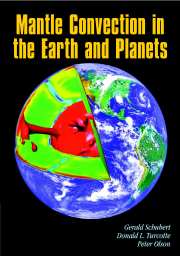Book contents
- Frontmatter
- Contents
- Preface
- 1 Historical Background
- 2 Plate Tectonics
- 3 Structure and Composition of the Mantle
- 4 Mantle Temperatures and Thermodynamic Properties
- 5 Viscosity of the Mantle
- 6 Basic Equations
- 7 Linear Stability
- 8 Approximate Solutions
- 9 Calculations of Convection in Two Dimensions
- 10 Numerical Models of Three-dimensional Convection
- 11 Hot Spots and Mantle Plumes
- 12 Chemical Geodynamics
- 13 Thermal History of the Earth
- 14 Convection in the Interiors of Solid Planets and Moons
- 15 Nature of Convection in the Mantle
- References
- Appendix: Table of Variables
- Author Index
- Subject Index
9 - Calculations of Convection in Two Dimensions
Published online by Cambridge University Press: 15 December 2009
- Frontmatter
- Contents
- Preface
- 1 Historical Background
- 2 Plate Tectonics
- 3 Structure and Composition of the Mantle
- 4 Mantle Temperatures and Thermodynamic Properties
- 5 Viscosity of the Mantle
- 6 Basic Equations
- 7 Linear Stability
- 8 Approximate Solutions
- 9 Calculations of Convection in Two Dimensions
- 10 Numerical Models of Three-dimensional Convection
- 11 Hot Spots and Mantle Plumes
- 12 Chemical Geodynamics
- 13 Thermal History of the Earth
- 14 Convection in the Interiors of Solid Planets and Moons
- 15 Nature of Convection in the Mantle
- References
- Appendix: Table of Variables
- Author Index
- Subject Index
Summary
Introduction
Although approximate solutions, such as those considered in the previous chapter, provide important insights into mantle convection, numerical solutions are required for a full understanding of the phenomenon. Ideally, numerical models should be three dimensional because whenever convection occurs in Nature it is invariably a three-dimensional phenomenon and thermal convection in the Earth's mantle is no exception to this rule. The evidence from plate tectonics and seismic tomography clearly indicates that the flow pattern is three dimensional beneath the lithosphere. However, even the largest computers are not adequate to model all the relevant physics of fully three-dimensional mantle convection. Two-dimensional numerical models of convection have therefore proven to be extremely useful for exploring the basic fluid mechanics of mantle convection.
The eventual goal of numerical modeling is to provide a complete picture of the flow with in the Earth's mantle. This would be analogous to the general circulation models (GCMs) used in weather forecasting and climate modeling. There are a number of difficulties associated with the development of a comprehensive mantle convection model:
The appropriate equations must be specified. We know what the appropriate fluid equations are and these have been presented in Chapter 6. However, we do not know all the nonfluid rheological laws that are important in mantle convection. For example, we are uncertain about how to model subduction and other types of lithospheric deformation which directly interact with the fluid processes at depth. The introduction of fault-like behavior into flow models is at an early stage of development (see Chapter 10) and the efforts in this direction are, so far, incomplete.
- Type
- Chapter
- Information
- Mantle Convection in the Earth and Planets , pp. 376 - 416Publisher: Cambridge University PressPrint publication year: 2001



